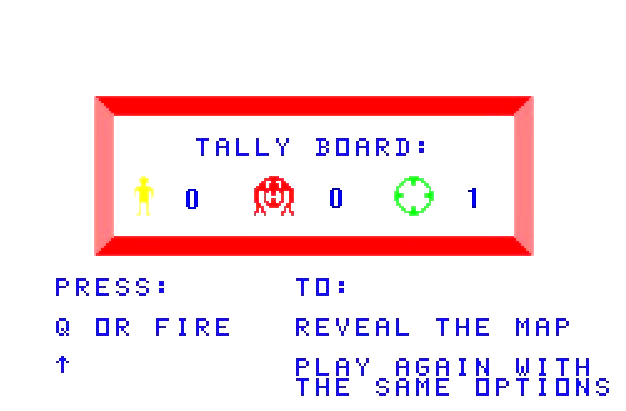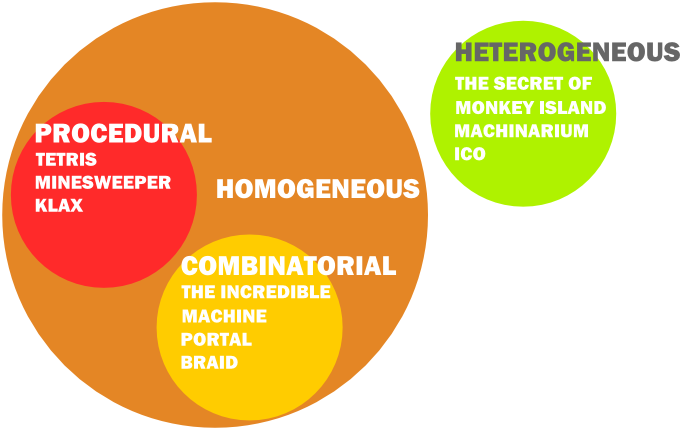
We asked five developers of interesting puzzle games how they did it: what they consider a good puzzle, what processes they follow, and how they zone in on fun and manage difficulty. We will publish these interviews in the upcoming weeks; this is just a quick introduction that sets the stage for the words of wisdom from the puzzle design experts.
Who did we ask?
(The links on the names link to the interviews.)
- Dave Hall (Q.U.B.E)
- Rob Jagnow (Cogs)
- Ted Lauterbach (suteF)
- Teddy Lee (My First Quantum Translocator)
- Guy Lima (Continuity)
Later in this article, we explain what all these games have in common.
You can also check out our comprehensive summary of the feedback we got from the game developers we interviewed: How Are Puzzle Games Designed (Conclusion).
What is a puzzle?
Definition time!
Puzzlemaster Scott Kim says,
A puzzle is fun, and has one right answer.
Jesse Schell gives us a more specific definition:
A puzzle is a game with a dominant strategy.
A dominant strategy is
… when choices are offered to a player, but one of them is clearly better than the rest …
Are you thinking about how this applies to Tetris and Angry Birds? When we look closely any of the definitions in our field, we see that there are annoying exceptions. Nevertheless, dominant strategy is a useful concept. Even when there is more than one possibility, the designer had a single possibility in mind. There must be a solution – even in Angry Birds, we know there must be a way to get all three stars. For the player, the fun is in finding the dominant strategy; for the designer, the challenge is in finding the sweet spot for that strategy, somewhere between trivial and merciless.
In action puzzle games such as Tetris the validity of the definition is less obvious, but it still applies: There is an ideal fit for each block. In theory, we could publish a book with all possible scenarios that a player can encounter, with the best move in each case. This book will then contain the dominant strategy for Tetris. In effect, good players construct such books in their heads – and learn to do lookups very quickly.
Puzzles History
 Puzzles go way back. Mazes have existed for at least 4000 years, although for the first 3000 years they had only one path (properly, these are called labyrinths, and they had religious significance and not entertainment value). More than 2500 years ago, the author of the Book of Judges in the Bible recorded the story of how Samson used a riddle to outsmart the Philistines
Puzzles go way back. Mazes have existed for at least 4000 years, although for the first 3000 years they had only one path (properly, these are called labyrinths, and they had religious significance and not entertainment value). More than 2500 years ago, the author of the Book of Judges in the Bible recorded the story of how Samson used a riddle to outsmart the Philistines
The oldest real puzzle that we know of is Archimedes’ Ostomachion, a puzzle that is similar to, but less elegant than, the legendary tangram puzzle. Archimedes’ Ostomachion is 2200 years old.
Puzzle games – such as treasure hunts and Twenty Questions – were around before the advent of computers. But it was computers that enabled us to turn puzzles into really challenging and engaging games. The earliest puzzle game that I could find is Hunt the Wumpus, released in 1972, the same year as PONG. In the early days, puzzles were most at home in adventure games (such as Collosal Cave Adventure, and Zork). Tetris (1985) added an element of action and become an icon that is still popular today. Puzzles eventually found their way into every genre, often enhancing action, strategy or story.
 Hunt the Wumpus (the 1980 version)
Hunt the Wumpus (the 1980 version)
Today, puzzle games is a huge genre, especially in casual markets. They make up huge portions of game repositories such as Apple’s iTunes App Store, and many of them are extremely popular: Angry Birds has had more than a 100 million downloads (source), and Cut the Rope more than 6 million (source).

Puzzles on Computer
Computers allowed us to turn puzzles into games; but what exactly does the computer offer to the puzzle game designer?
- New forms of play: Computers allow puzzles to have mechanics that are impractical, clumsy or impossible in real life or on paper (Tetris , My First Quantum Translocator, Q.U.B.E.).
- New experiences: Computers allow us to enrich puzzles with compelling narrative (Braid, sFute, Portal), or to embed them in other games (such as RPGs).
- New structures: On a computer, it is easier to string puzzles together into a unified, structured experience, making it possible to train players, to give them a sense of progression, and to award players by revealing more content (Continuity).
- New design strategies: Computer prototyping makes it easier to test many more puzzles, which is a boon in physics-based puzzles (The Incredible Machine, Cogs).
Edit (26 April 2011): I have just discovered a similar list in On Game Design by Andrew Rollings and Ernest Adams. From their list, I add:
- New design strategies*: We can use the computer to automate puzzle design or certain aspects thereof: the computer can be used to construct puzzles and “design” levels procedurally, or to find solutions or hints automatically.
- New experiences*: Computers allow us to add animation and sound to make puzzles more interesting and engaging.
- New playing aids: With the computer, we can record moves, allow undo, and give hints.
- New ways to compete: Computers allow us to compute scores easily, and make it possible to compete with ourselves and others. With the Internet, it is also possible to build a community and social activities around puzzles, something that is harder to do with physical puzzles.
Puzzle and Puzzle Game Classification
Classification by domain and gameplay
We can classify puzzle games by the skills that players need to solve them:
- mathematics (arithmetic, logic, space) (sudoku, chess puzzles, tangrams, Clue, Minesweeper, mazes, Rubik’s Cube),
- physics (Greek puzzle mugs, The Incredible Machine, Angry Birds, Bridge Builder),
- visual field (spot-the-difference and hidden-object puzzles),
- language (crossword puzzles, word-search puzzles, Scrabble, Hang Man),
- common sense and situations (riddles, adventure games, treasure hunts, Twenty Questions).
The domains above are so broad that we can subdivide each one even further by the type of play they allow. In fact, there are so many categories that it’s impossible to list them all in such a short introduction as this. You can find a good classification of puzzles (excluding puzzles in video games) on the Puzzle Museum site. For video games, see the Wikipedia entry Puzzle Video Game (unfortunately, a rather poor article).
Classification by design
If we strip away what the puzzles are about, we are left with how the designers put together the core mechanics to create a game. The way I see it, there are three basic groups:
At the one extreme we have procedural puzzle games. The designer designs the core mechanics and then allows the computer to put them together to create puzzles for the player – often randomly. Examples include Tetris and Minesweeper. The designer can control the difficulty by limiting the elements that the computer may use and by scaling the puzzle (making it bigger or faster). There is no level design in these games.
At the other extreme, in heterogeneous puzzle games, the designer designs mechanics for each puzzle. Adventure games are typical examples of this type of puzzle game, and typical puzzles require a combination of common sense and lateral thinking to solve. The designer can increase the difficulty by making the solutions to the puzzles more obscure, or stringing them together into more complicated goal-subgoal systems.
Between these extremes, there are combinatorial puzzle games, where the core mechanics are reused often, and in many combinations. Levels are carefully designed, and not created procedurally. Games like Portal and Braid fall into this category. Difficulty increases when the designer introduces more mechanics, use mechanics more cleverly, and combine more mechanics into each next puzzle.
All the games we chose for this series of interviews are of the last type: combinatorial puzzle games.

What can other games benefit from combinatorial puzzle design principles?
The design principles behind this type of puzzle game apply to all games and help designers to focus on the mechanical and structural aspects of a game. In particular, these puzzle games help designers to zero in on
- mechanics;
- level design;
- teaching mechanics and gameplay principles to the player;
- revealing information and content;
- complexity of combining mechanics;
- difficulty and progression;
- perception shifts (using mechanics in unusual ways).
By looking at how designers approach puzzle games, we can also get hints about approaching game design in general.
Sources
- The Art of Game Design: A Book of Lenses. Jesse Schnell (p. 209).
- On Game Design. Andrew Rollings and Ernest Adams (p. 490).
- Video Game Explosion. A Hisotry from PONG to Playstation (R) and beyond (p. xvii-xxi).
- Wikipedia: Dates of games not found in Video Game Explosion were taken from their entries in Wikipedia.
Other Resources
The Art of Puzzle Game Design
http://www.scottkim.com/thinkinggames/index.html
Scott Kim provides a tonne of useful information on his site, with many case studies and handy breakdowns of key issues.
The Game Prodigy on Puzzle Design
http://thegameprodigy.com/category/puzzle-game-design/
A variety of puzzle game design articles.
Tony Delgado : Beyond Tetris
http://www.gamesetwatch.com/column_beyond_tetris/
A puzzle-game column that ran during 2006 and 2007.
Pingback: Indie Game Links: A Bundle of Joy | Casual Flash Game News – Hidden Objects – Match 3 and Spot the Differences
Pingback: Starting Up « philipconrad
Thanks 🙂
awesome, thanks for share…
Pingback: Puzzle Game Reading « Projects I Won’t Finish
There is a significant section on puzzle design in the book: “Swipe This! The guide to great touch screen game design” by Scott Rogers, Wiley & Sons, 2012
Yup indeed, a very cool book. This article was before the book, and indeed the book quotes a piece from this article.
The classification into homogenous and heterogenous puzzles feels broken – or at least the examples are. Many adventure games are very homogenous; they have one mechanic: using items.
An actually heterogenous game would be just bad, because you don’t learn if every puzzle is different. It might work if the puzzles form some kind of narrative, but i seriously doubt it.
Ecstatic I discovered this site. Even happier it’s South African. Big up to you all for an excellent, diverse and fun resource for creating games.
Keep up the amazing work.